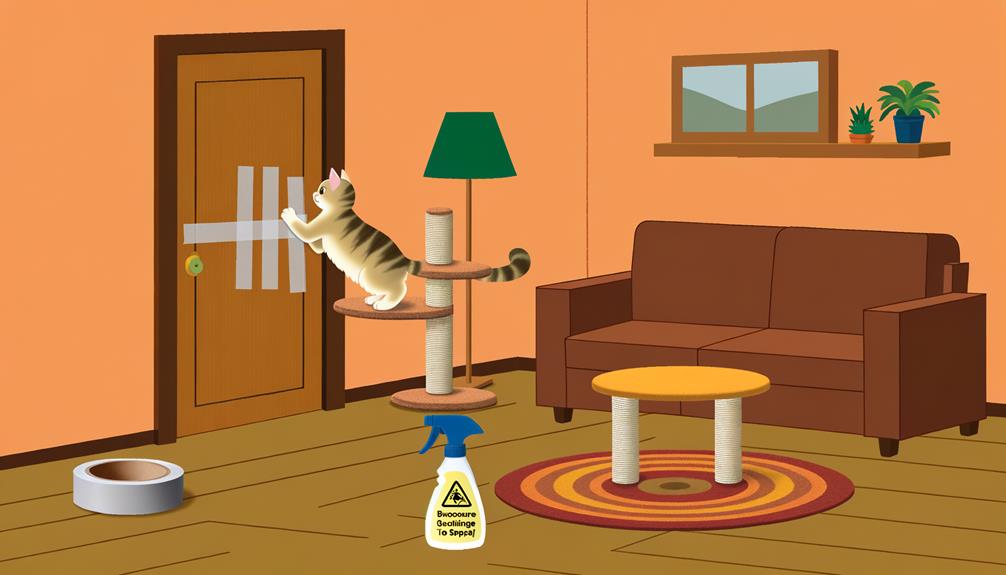Dealing with a cat that scratches the door can be frustrating, but there are effective strategies to manage this behavior. You might wonder why your cat insists on this habit, and understanding their motivations is the first step. Have you considered providing alternative scratching surfaces or keeping their nails trimmed? These are just a few initial tactics that can make a noticeable difference. But what about addressing their need for mental stimulation and physical exercise? There's more to explore, including deterrent methods and environmental changes, that could transform your home and your cat's behavior.
Understand Cat Scratching Behavior
Scratching is a natural behavior for cats that serves multiple important purposes. It's not just about sharpening claws; it's a multifaceted activity that includes stretching muscles, maintaining nail health, and marking territory with the scent glands located in their paws. Understanding cat behavior is significant in addressing why your feline friend might be scratching doors.
One common trigger is closed doors. Cats are inherently curious creatures, and a shut door can lead to anxiety and frustration. They might scratch to express their need to access the room, investigate what's behind the barrier, or even reclaim perceived lost territory. This behavior is often intensified if the door separates them from their owner, amplifying their sense of isolation.
Attention-seeking behavior is another major factor. Cats may scratch doors to gain your attention, particularly when they feel neglected or bored. In these cases, the scratching is less about the door itself and more about prompting you to interact with them. It's a cry for mental stimulation and engagement, crucial for their overall well-being.
Mental stimulation—or the lack thereof—plays a key role in scratching habits. Cats need both physical and mental challenges to stay content. Without these, they can develop destructive behaviors as an outlet for their pent-up energy and frustration. Scratching posts, toys, and interactive play sessions can help mitigate this by providing appropriate outlets for their natural instincts.
To effectively manage and reduce door scratching, it's important to understand these underlying motivations. Addressing the root causes will not only curb the behavior but also improve your cat's overall happiness and health.
Provide Alternative Scratching Surfaces
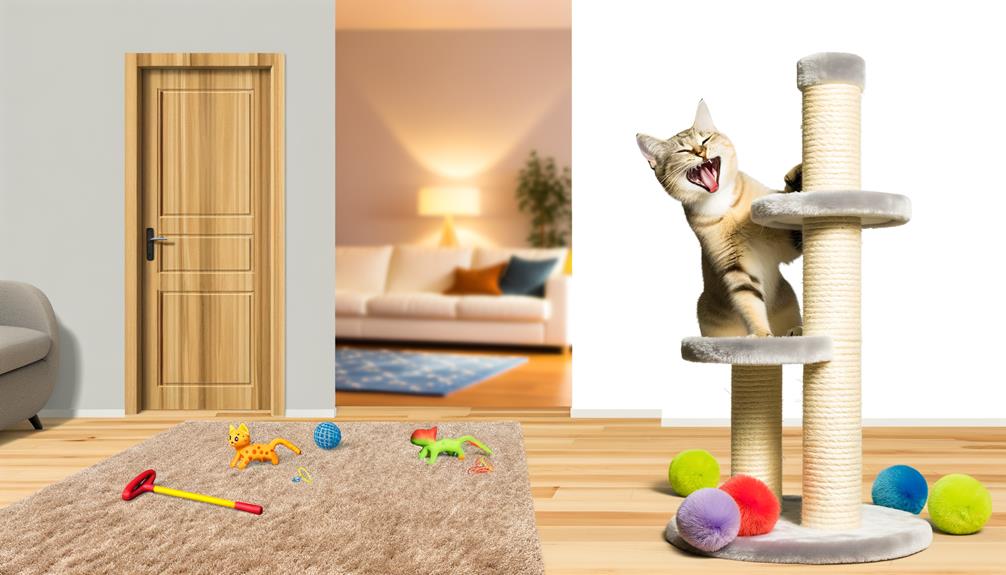
Understanding the various motivations behind your cat's door scratching is just the first step. Effective management involves providing alternative scratching surfaces that cater to your cat's natural instincts. Scratching posts made of materials like sisal, carpet, or cardboard can successfully redirect your cat's scratching behavior away from doors.
Place these scratching posts strategically in areas your cat frequently scratches, particularly near the door. This positioning encourages your cat to use these alternative scratching surfaces instead. Sprinkling catnip on the posts can further attract your cat and increase the likelihood of them adopting these designated areas for their scratching needs.
It's essential that scratching posts are tall and sturdy. Cats need to stretch and scratch comfortably, which is important for their exercise and territory marking. A stable and tall post allows them to fully engage in this natural behavior without resorting to door scratching.
To maintain your cat's interest and prevent boredom, regularly rotate and introduce new scratching surfaces. A variety of textures and forms can keep your cat engaged and reduce the temptation to scratch the door. This variety not only satisfies their physical needs but also provides mental stimulation, further decreasing unwanted scratching behavior.
Regular Nail Maintenance
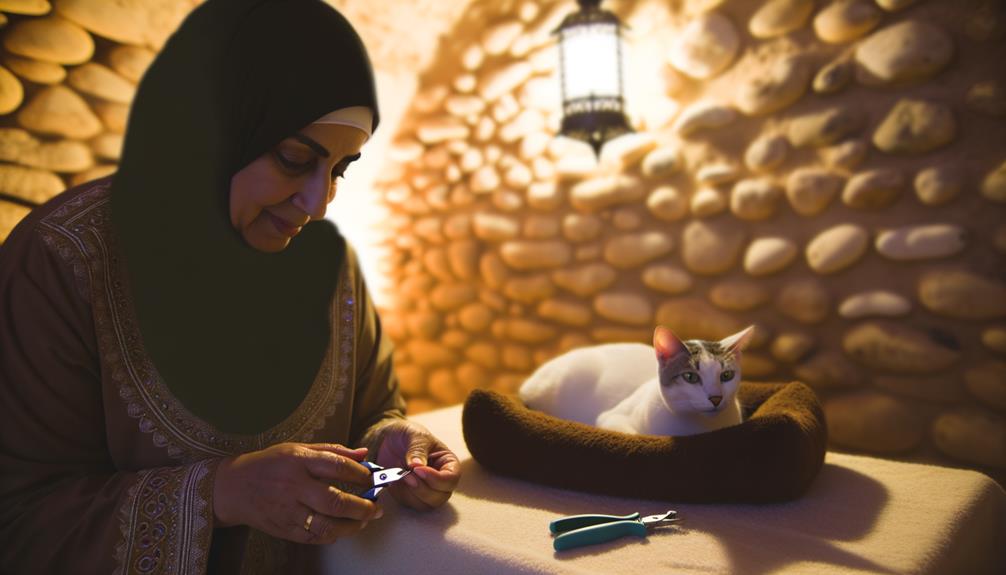
Regular nail maintenance is essential for managing your cat's scratching behavior. By regularly trimming your cat's nails every 2-4 weeks, you can greatly reduce the potential damage from scratching, making it less likely for them to target doors. Keeping your cat's nails at a manageable length not only protects your furniture and doors but also promotes their overall paw health and comfort.
To effectively manage claws, you should invest in a high-quality cat nail trimmer. These trimmers are designed to cut your cat's nails safely and efficiently, minimizing the risk of injury. If you're unsure about trimming your cat's nails yourself, professional grooming services are an excellent alternative. Professional groomers have the expertise to trim your cat's nails correctly, ensuring their safety and comfort.
Consistent nail maintenance acts as a preventative measure, reducing the likelihood of scratching behavior by limiting the need for cats to file their claws on surfaces like doors. By maintaining shorter nails, you reduce their ability to cause considerable damage, thereby helping to preserve both your home and your cat's well-being.
Consider using nail caps as an additional layer of protection. These small, soft coverings can be applied to your cat's claws, further reducing their ability to scratch surfaces. Nail caps are especially useful if your cat is particularly persistent in its scratching habits, providing an extra safeguard for your doors and furniture.
Increase Physical Exercise
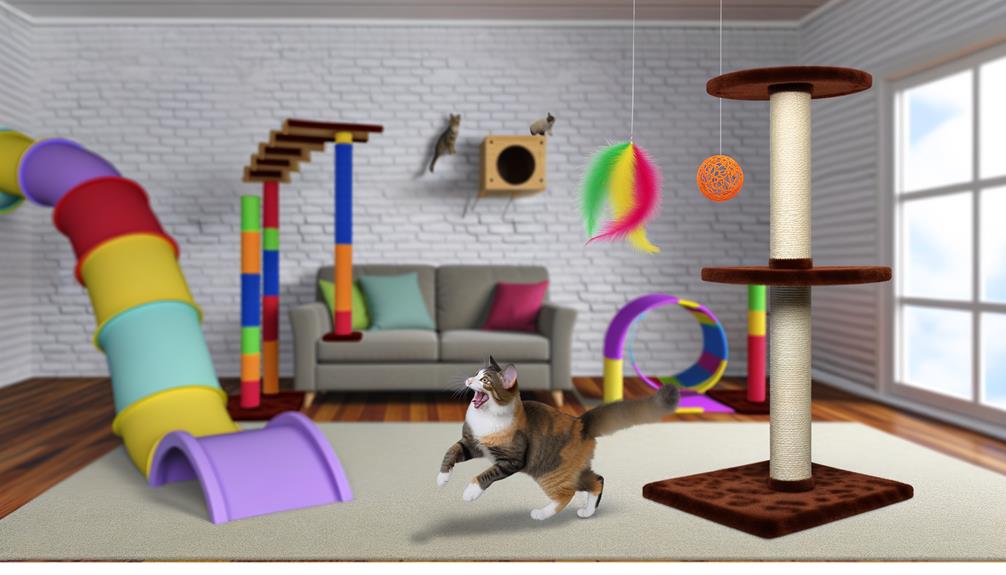
Engaging your cat in interactive play sessions for at least 15-30 minutes daily can greatly reduce door scratching by mimicking their hunting instincts. Providing a variety of toys, such as feather wands and laser pointers, will keep them mentally stimulated and physically active, decreasing boredom-related behaviors. Establishing a consistent evening play routine can help tire out your cat before bedtime, promoting a calmer environment.
Engaging Interactive Play
To greatly reduce your cat's door scratching behavior, incorporating interactive play into their daily routine is vital. Engaging your cat with stimulating toys that mimic prey, such as feather wands or laser pointers, can effectively tap into their natural hunting instincts. This type of interactive play helps expend their energy levels, making them less likely to scratch doors out of boredom or excess energy.
Implementing a variety of toys and rotating them regularly keeps your cat engaged and mentally stimulated. Scheduled playtime, ideally for 20-30 minutes a day, is vital. This consistent activity can help manage your cat's energy levels, providing both physical and mental exercise. By doing so, you can create a calmer environment, reducing the likelihood of your cat scratching at doors for attention or stimulation.
Interactive play before bedtime can be particularly beneficial. It tires out your cat, leading to a more restful night for both of you. A well-exercised cat is generally more content and less prone to destructive behaviors. Hence, integrating regular, interactive play sessions into your cat's routine is a practical and effective strategy to reduce scratching and promote overall well-being.
Scheduled Exercise Sessions
A well-planned exercise routine can work wonders in curbing your cat's door scratching behavior. Engaging in scheduled exercise sessions, such as interactive play with feather wands or laser pointers, greatly reduces your cat's pent-up energy, which may otherwise lead to unwanted scratching. Given that cats are naturally crepuscular, they're most active during dawn and dusk. Scheduling playtime during these hours aligns with their instincts and helps expend energy effectively.
Short, frequent sessions of about 15-20 minutes are ideal for providing both physical and mental stimulation, reducing boredom-related scratching behavior. Make sure to incorporate varied toys and change them regularly to sustain your cat's interest and motivation. This variety not only keeps them engaged but also helps prevent destructive scratching.
Regular exercise through scheduled playtime doesn't just decrease scratching; it also promotes overall health, reducing the risk of obesity and related health issues. By maintaining these scheduled exercise sessions, you can greatly reduce your cat's scratching behavior, ensuring a happier, healthier pet. Interactive play is key to reducing boredom and promoting a harmonious living environment for both you and your feline friend.
Utilize Deterrent Methods
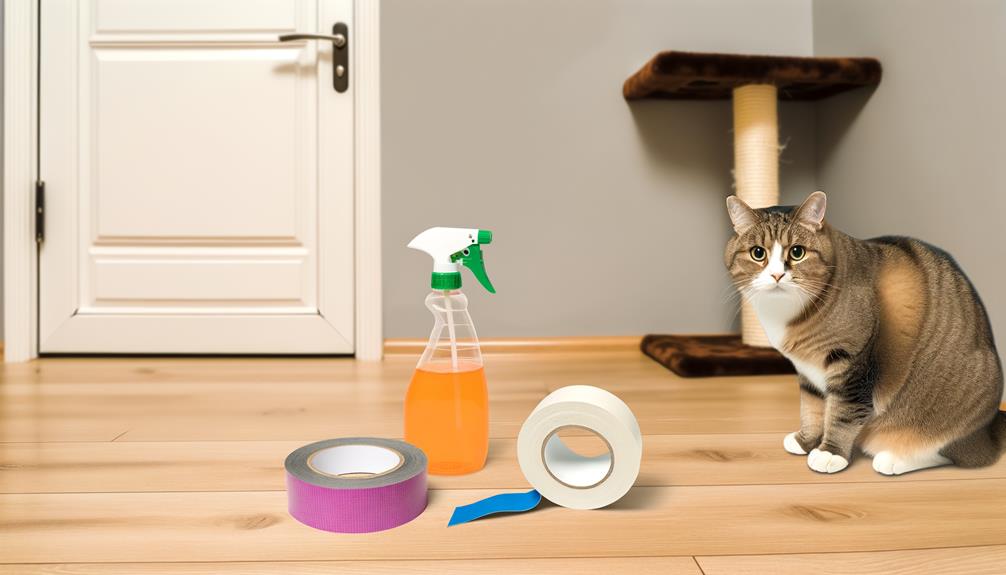
Applying deterrent methods can effectively prevent your cat from scratching the door. By making the environment less appealing for scratching, you can protect your home and maintain your cat's well-being. Here are some proven strategies to contemplate:
- Double-Sided Tape: Applying double-sided tape to doors creates an uncomfortable surface for cats. They dislike the sticky sensation on their paws, which can deter them from scratching those areas.
- Cat-Deterring Sprays: Utilizing cat-deterring sprays, especially those containing citrus or essential oils, can effectively repel cats. The unpleasant smell created by these sprays discourages your cat from approaching the door. Alternatively, you can make homemade sprays using water mixed with essential oils like lavender or eucalyptus.
- Motion-Activated Devices: Installing motion-activated devices that emit a harmless burst of air can startle cats and discourage them from approaching the door. These devices are effective as they provide immediate feedback to the cat's unwanted behavior without causing harm.
- Physical Barriers: Incorporating physical barriers such as transparent plastic sheeting or baby gates can protect doors from scratches. Transparent plastic sheeting allows visibility for the cat while preventing direct contact with the door, thereby reducing the likelihood of scratching.
Regularly using non-toxic deterrents like homemade sprays reinforces boundaries and reduces scratching behavior over time. By combining these methods, you create a multi-layered defense against door scratching, ensuring a more harmonious living environment for both you and your feline friend. These techniques are designed to be safe and effective, minimizing stress for your cat while protecting your home.
Implement Environmental Modifications

When aiming to modify your cat's environment to curb door scratching, consider introducing alternative scratching surfaces that cater to their natural instincts. Providing scratching posts made of various materials like sisal, carpet, or cardboard near the door can help redirect your cat's behavior from scratching the door to these more appropriate surfaces. Placing these posts strategically can make it easier to stop cats from scratching areas they shouldn't.
Installing cat doors is another effective strategy. These allow your cat to access restricted areas without needing to scratch at closed doors, reducing both frustration and territorial behavior. By giving your cat the freedom to move between rooms, you'll create a more harmonious environment from a different perspective.
Incorporating cat trees and climbing structures within your home can also make a significant difference. These additions provide your cat with ample opportunities for scratching, climbing, and playing, which can alleviate boredom and reduce the likelihood of them scratching as a form of attention-seeking behavior. Interactive toys and perches can further stimulate their mind and body, promoting overall well-being.
To deter your cat from specific areas, consider using cat-deterring sprays with scents that cats dislike, such as citrus or cinnamon. These sprays can be applied to the door to make it less appealing for scratching. Additionally, applying double-sided tape or bubble wrap on the door creates an uncomfortable surface, further discouraging the behavior.
Lastly, don't forget to use positive reinforcement. Reward your cat with treats or affection when they use the scratching posts or other designated items. This encourages them to continue using the appropriate surfaces instead of scratching the door.
Seek Professional Guidance
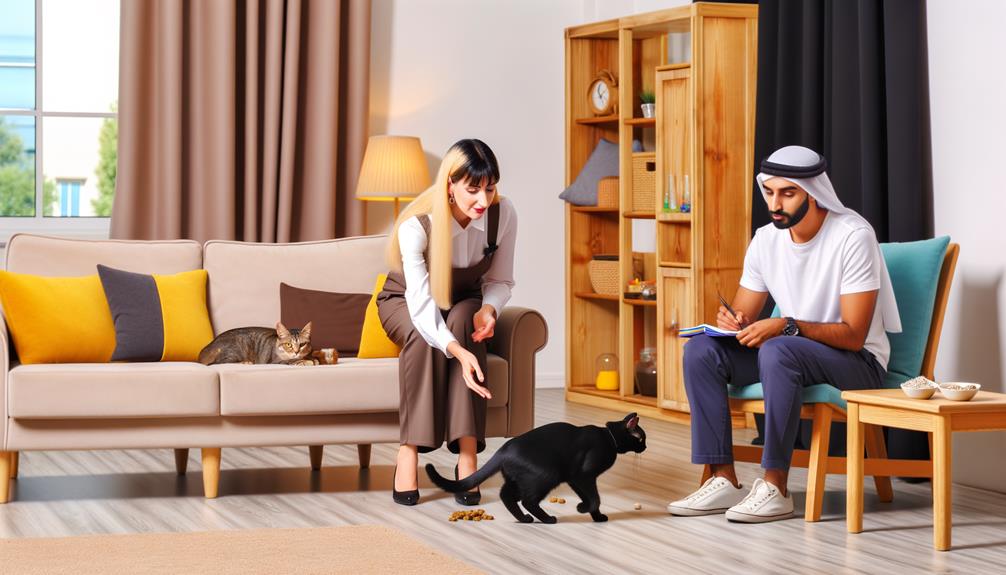
If your cat's scratching behavior persists despite environmental changes, it's time to consult a veterinarian to rule out any health issues. A certified animal behaviorist can then provide tailored strategies to address stress or anxiety-related scratching. Regular check-ups and expert advice will help you monitor and adapt your approach, ensuring your cat's well-being.
Consult a Veterinarian
Consulting a veterinarian is an essential first step to guarantee your cat's door-scratching behavior isn't linked to underlying health issues. When you consult a veterinarian, they can identify any medical conditions, such as anxiety or pain, that might be causing excessive scratching behavior. This step is vital for several reasons:
- Identify Underlying Health Issues: Your vet can perform a thorough examination to rule out health problems that might be driving your cat's scratching behavior.
- Behavior Modification Strategies: A veterinarian can provide personalized behavior modification strategies tailored to your cat's specific needs and personality.
- Referral to Specialists: If the issue is complex, your vet might refer you to a certified animal behaviorist who can provide more specialized care.
- Regular Veterinary Check-ups: These help monitor your cat's overall health and behavior, making it easier to spot any changes that could lead to problematic scratching.
Behavioral Specialist Advice
Engaging a certified animal behaviorist can be a game-changer in addressing your cat's door-scratching behavior. These professionals possess specialized knowledge in feline behavior modification, allowing them to develop tailored strategies that effectively address your cat's specific needs. By consulting a certified animal behaviorist, you can identify underlying issues such as anxiety or boredom that may contribute to the scratching behavior.
Professional behaviorists are adept at creating a thorough management plan that not only addresses the behavior but also considers your cat's overall well-being. They often incorporate positive reinforcement techniques, which can greatly improve the success of behavior modification efforts. Consistent routines and rewarding desired behaviors are pivotal in helping your cat adapt to new habits.
Additionally, regular consultations with a veterinarian can rule out any underlying medical conditions that might be causing sudden changes in your cat's scratching behavior. This guarantees that both health and behavioral concerns are addressed thoroughly. Access to resources and support from experts enhances your understanding of feline behavior, leading to more effective and compassionate solutions for managing door scratching. With a professional's guidance, you can achieve a harmonious living environment for both you and your cat.
Monitor and Adapt Strategies
Monitoring your cat's scratching behavior is essential for identifying triggers and patterns, enabling you to adapt your strategies effectively. Keeping a detailed diary of scratching incidents will provide you with valuable insights into specific times or situations that provoke the behavior. This can help you implement targeted interventions and enhance the effectiveness of your approach.
Here are some steps to monitor and adapt strategies:
- Keep a Diary: Document every scratching incident, noting the time, location, and any preceding events.
- Consult a Veterinarian: Rule out underlying health issues that could contribute to sudden or increased scratching behavior.
- Seek Professional Guidance: Engage a certified animal behaviorist for personalized strategies tailored to your cat's unique needs.
- Regular Assessment: Regularly evaluate the effectiveness of your interventions and be willing to adjust your approach for long-term success.
